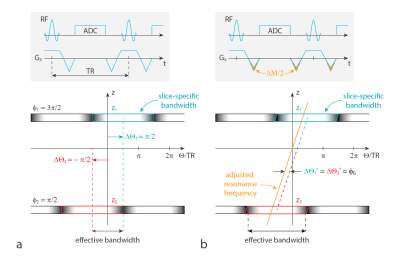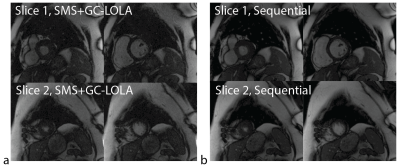0244
Gradient-Controlled Local Larmor Adjustment (GC-LOLA) for CAIPIRINHA-Accelerated bSSFP Imaging with Improved Banding Behavior1The Centre for Advanced Imaging, The University of Queensland, Brisbane, Australia, 2Department for Diagnostic and Interventional Radiology, University of Würzburg, Würzburg, Germany, 3Siemens Healthcare, Erlangen, Germany
Synopsis
The simultaneous multi-slice (SMS) imaging technique CAIPIRINHA has proven to be highly efficient for extending the slice coverage in 2D imaging. When accelerating balanced steady-state free-precession (bSSFP) sequences with SMS-CAIPIRINHA, modulating k-space by means of slice-specific RF phase cycles leads to undesired slice-specific shifts of the bSSFP pass-band structure. Gradient-controlled local Larmor adjustment (GC-LOLA) removes this drawback. By means of slice gradient unbalancing, the Larmor frequency is made slice position dependent, which allows compensating for the pass-band shifts and stabilizes CAIPIRINHA-accelerated bSSFP imaging with respect to B0 field inhomogeneity.
Target Audience
Researchers interested in bSSFP and
simultaneous multi-slice imaging (CAIPIRINHA).Introduction
Balanced steady-state free-precession (bSSFP) imaging has become the standard acquisition technique for applications such as cardiac MRI by providing an intrinsically high signal-to-noise ratio (SNR), a unique contrast, short acquisition times and robustness in the presence of flow and motion. Accelerating bSSFP with the simultaneous multi-slice (SMS) imaging technique CAIPIRINHA1 has been shown to be highly SNR efficient for extending the slice coverage in 2D imaging2, and two distinct methods, namely RF phase cycling based encoding2 and blipped gradient encoding3 can be employed. The first provides each slice with an individual RF phase cycle, which conserves the sequence’s robustness to flow and motion, but leads to a higher susceptibility to B0 field inhomogeneity. The second, by contrast, employs balanced slice gradient blipping4 to realize the combination. This, however, involves toggling the gradients every TR, potentially increasing the sensitivity to eddy currents, particularly for small inter-slice distances.
In this work, we propose a new method, called gradient-controlled local Larmor adjustment (GC-LOLA) that eliminates the drawback of the first approach and stabilizes CAIPIRINHA accelerated bSSFP imaging with respect to B0 field inhomogeneities.
Theory
SMS-CAIPIRINHA excites multiple slices at the same time and shifts them with respect to each other in the FOV by providing each slice with a specific phase modulation in k-space. When combining SMS-CAIPIRINHA with bSSFP, this phase modulation has to be generated while maintaining the bSSFP steady state within each simultaneously excited slice. To achieve this, the RF phase cycling based encoding technique (2) uses an individual RF phase cycle in each slice. The phase of the jth RF pulse in slice s is given by:
$$ \psi_{S}(j) =\phi_{S} \cdot j + C_{S} $$
with $$$\phi_{S}$$$ being the RF phase increment and $$$C_{S}$$$ denoting an arbitrary slice-specific constant. With respect to standard bSSFP, an undesired slice-specific shift $$$\Delta \Theta_{S} = (\phi_{S}-\pi)$$$ of the pass-band structure along the off-resonance axis is introduced, effectively reducing the overall off-resonance robustness depending on the phase cycling employed (Fig. 1a).
Gradient-controlled local Larmor adjustment (GC-LOLA) eliminates this drawback and removes the bSSFP pass-band shifting by:
- slightly unbalancing the slice-select gradient so that the Larmor frequency difference between the individual slices compensates for the pass-band shifting (Fig. 1b), and
- modifying the RF phase cycles homogeneously across all slices to align the centers of the pass-bands to resonance.
A simple two-slice example is given in Fig. 1. The two slices S1 and S2 located at z1 and z2 are acquired using the RF phase cycles with $$$\phi_{1,2} = \pm \pi/2$$$. The off-resonance bandwidth is effectively reduced by a factor of two (Fig. 1a). To correct for the pass-band shift, the slice gradient is unbalanced by the momentum
$$ \Delta M = \frac{\phi_{1}-\phi_{2}}{\gamma(z_{1}-z_{2})} $$
which might be evenly distributed on the slice pre- and rephaser. The remaining residual pass-band shifts $$$\Delta \Theta_{1}^{*}$$$ and $$$\Delta \Theta_{2}^{*}$$$ may be corrected for by subtracting
$$\phi_{G} = \frac{\phi_{2}z_{1}-\phi_{1}z_{2}}{z_{1}-z_{2}}$$
from $$$\phi_{1}$$$ and $$$\phi_{2}$$$ (Fig. 1b).
Methods
To test the concept, phantom experiments and in-vivo cine cardiac MRI were performed on a 3 T and 1.5 T whole-body system (MAGNETOM Aera and Skyra, Siemens Healthcare, Erlangen, Germany), respectively, using a bSSFP sequence prototype in-house modified to support SMS-CAIPIRINHA with simultaneous two-slice excitation, GC-LOLA and online image reconstruction5. All SMS acquisitions were compared to sequential single-slice acquisitions of the same slices. For the phantom measurements, artificial banding artifacts were introduced by modifying the shim currents.Results
Figure 2 demonstrates the successful restoration of the original bSSFP banding structure for a SMS-CAIPIRINHA measurement using GC-LOLA in a phantom. The tilt of the resonance frequency axis with respect to the slice-encoding axis slightly widens the banding artifacts. The benefit of increasing the off-resonance robustness can be seen from the cardiac SMS-CAIPIRINHA volunteer scan displayed in Fig. 3. For both the SMS-CAIPIRINHA acquisition and the sequential acquisition of the two slices, the banding artifacts appear at the same locations, indicating the successful restoration of the off-resonance behaviour in both slices.Discussion
GC-LOLA was successfully employed to remove the phase-cycling-induced pass-band shifts in SMS-accelerated bSSFP imaging with RF phase cycling based CAIPIRINHA encoding. The proposed method facilitates extending the slice coverage in 2D bSSFP imaging by means of simultaneous multi-slice excitation without sacrificing the effective off-resonance bandwidth or eddy current stability. According to the measurements performed so far, the unbalancing does not lead to detrimental flow sensitivity. In particular, measurements at higher fields such as 3 T are considered to benefit from GC-LOLA.Acknowledgements
No acknowledgement found.References
- Breuer FA, Blaimer M, Heidemann RM, et al. Controlled aliasing in parallel imaging results in higher acceleration (CAIPIRINHA) for multi-slice imaging. Magnetic Resonance in Medicine 2005;53:684–69.
- Stäb D, Ritter CO, Breuer FA, et al. CAIPIRINHA accelerated SSFP imaging. Magn. Reson. Med. 2011;65:157–164.
- Duerk J, Griswold M, Dara K. Multi-slice Blipped TrueFISP-CAIPIRINHA. United States Patent Application US 9,086,468 (2015).
- Setsompop K, Gagoski BA, Polimeni JR, et al. Blipped-controlled aliasing in parallel imaging for simultaneous multislice echo planar imaging with reduced g-factor penalty. Magn. Reson. Med. 2012;67:1210–1224.
- Stäb D, Speier P, et al. Restating MS-CAIPIRINHA as an In-Plane Acceleration Problem: an
Efficient Method for Integrating High Coverage Cardiac Perfusion MRI
Into Clinical Workflow. Proc. Intl. Soc. Magn. Reson. Med 23 (2015), #2686.
Figures


